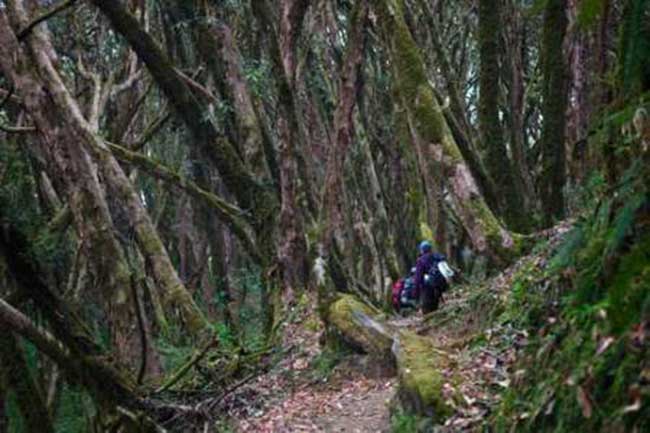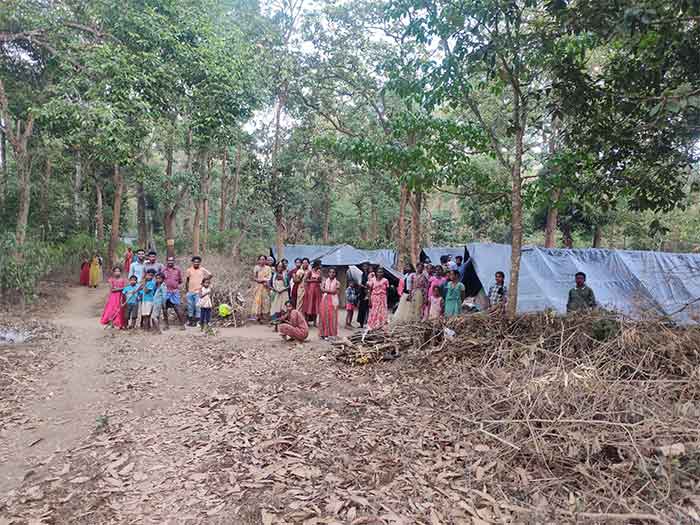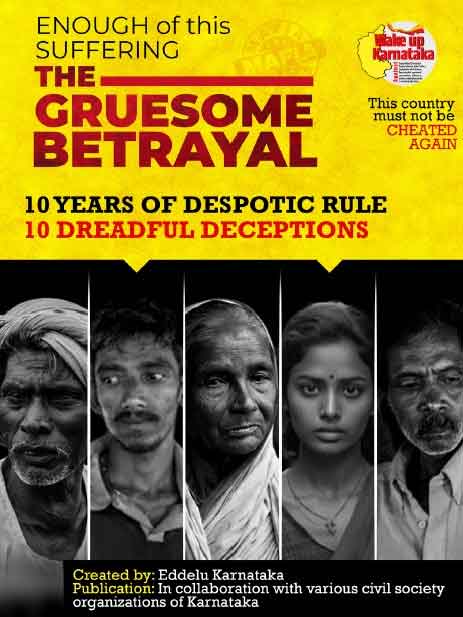
The reintroduction of a multiparty system in Nepal in 1990 after the peaceful revolution against the autocratic Monarchial Panchayat regime1 provided political space for communities to get organized and manage common pool resources, including water and forest. The state established new policies and funding mechanisms to support the evolution of new types of grassroots-based, self-governing institutions. The energies released from this self-governance movement resulted in a powerful expansion of community forests in Nepal, which has directly benefited about 1.7 million households, or about 32 percent of the population, organized into 16,000 community forestry user groups (CFUGs) that manage 1.2 million hectares of land, or about one fourth of Nepal’s forested areas.
HISTORY OF COMMUNITY FORESTRY
Until their nationalization in 1957, forests belonged to the people. However, it was difficult if not impossible for the government to manage vast tracts of nationalized forests because it lacked any forest administration and it could not easily oversee remote and isolated rural areas. Communities therefore pressured the government to let them take control of forests, particularly in the hills. In 1978, this pressure led to a new forest regulation that transferred the management of some of the forests to local bodies, namely Panchayats. Despite this law, however, only 48,541 hectares of forests had been handed over by 1986.
The government recognized the need for active citizen participation in the design process for natural resource management by formally including community organizations in the government’s eighth Five Year Plan (1992–1997) for effective delivery of public goods and services. The Forestry Act of 1993 and additional forest regulations in 1995 provided authority to (CFUGs) to manage forests. While the state retained ownership of the forests, it gave community groups the right to manage their forests.
RIGHT TO SELF-GOVERNANCE
- Communities have rights to form community forestry user group (CFUG) based on their willingness, capacity and customary rights.
- Community forest boundaries will not be restricted to existing administrative or political boundaries.
- Government can dismantle a CFUG if the latter is found to engage in large-scale deforestation, but it is the duty of the government to reconstitute the CFUG.
- CFUGs can elect, select or change their executive committee at any time.
- CFUGs can sanction members for breaking the rules.
- CFUGs can amend or revise their constitution any time.
RIGHT TO FOREST MANAGEMENT AND UTILIZATION
- There is no limit to the forest area that can be handed over to communities. CFUGs are authorized to:
- Make optimal use of their forests by growing cash crops together with forest crops;
- Mortgage their standing forest products with financial institutions to obtain loans;
- Utilize funds for any purpose, but 25 percent of any revenue from forest must be spent on forest development;
- Freely set prices and sell their forest produce;
- Set up business enterprises and make profits;
- Seek support from any organization;
- Raise funds through various forest products, with all income going to the CFUG and no requirement to share revenues with government; and
- Invest in any areas, persons and development activities according to the decision of the general assembly.
MORE SUSTAINABLE LIVELIHOODS THROUGH COMMUNITY FORESTRY
Community management of Nepalese forests has resulted in many ecological and economic benefits, including increased crown cover and higher productivity. A recent study reported that 74 percent of the forest areas managed by the CFUGs was in “good” condition compared to 19 percent in “degraded” condition. Others have reported that CFUGs compare favorably to state forests in terms of changes in forest condition (Nagendra et al. 2008).
The impact of community forestry has fueled the production of wood, timber, fodder and organic matter and non-timber forest products (NTFP) while increasing forest cover and protecting the watershed, resulting in higher discharges of water. In addition, the revenue generated by the CFUGs has been used for financing microenterprises operated by poorer users and for village infrastructure projects. In some cases land-poor segments of the community have cultivated NTFP and other forest products. In other cases CFUGs have started forestry-related communitarian enterprises such as a plant to process medicinal herbs.
According to a study on impact on livelihoods (Ojha and Chchatre 2009) community forestry has had a positive impact on livelihoods and food security. Moreover, a longitudinal five-year study covering 2,700 households from 26 CFUGs in the Koshi Hills showed large-scale improvements on people’s livelihoods and food security. It showed that 46 percent of the poor users improved their economic situations and long-term capacities due to their participation in CFUGs. A separate study found that the annual household income of forest users increased by 113 percent over a period of 2003-2008, from Nepalese Ruppias (NRs) 54,995 in 2003 to NRs 117,075 in 2008 (US$710 to $1,512). This represents a 61 percent increase after adjusting for inflation.
The importance of forests as reservoirs to preserve water is often overlooked. Yet that is where the linkage between forests, agriculture and improved quality of life is really noticeable. It is therefore important to foster a holistic, integrated multi-sectoral approach to natural resource management as the best way to improve the quality of livelihoods, especially for the poor. Participatory action research (PAR) involving primary stakeholders is an essential part of this management model because community groups can build their capacities for self-governance only if they can build trust and reciprocity and enhance their ability to resolve inevitable problems and conflicts.
Finally, CFUGs that effectively manage their forests have been able to provide carbon sequestration and environmental services, including the provision of higher-quality water to downstream communities. Under Reducing Emissions from Deforestation and Degradation (REDD), an effort is made to quantify such gains so that a proper compensatory mechanism can be made to reward CFUGs according to their contribution in improving the environment. A community Forestry Fund can help in regenerating forests and creating livelihood opportunities for users. The resources generated from carbon trading and environmental services can be placed into the fund.
As this account suggests, CFUGs could become a vanguard innovator for improved natural resource management in Nepal, building on the energies released by the communitarian movement since 1990. The constitution of CFUGs has provisions for intervening to improve the livelihoods of the poor.
CFUGS BY-LAWS THAT HELP THE POOR
- Price subsidies for forest products.
- Reservation of community forest slots for poor women and Dalits (“untouchables”) and participation in decision-making bodies.
- Special provisions for the distribution of forest products to vulnerable groups (for example, charcoal to blacksmiths, products freely distributed to victims of natural disasters, single women and conflict victims).
- Allocation of CFUG funds at low interest rate for income- generating activities.
- Allocations of community forestry land to poor users. Scholarships to children from poor families.
THE CHALLENGES OF COMMUNITY FORESTRY IN TERAI
In Terai, a very dry region in Southern Nepal, the forest cover is being depleted by farming in both the hills and the Indian part of the fertile Gangetic plain. Terai is home to people of Indian origin, an indigenous population called Tharus and people who migrated from hills. This mix of people of different communities makes collective action more difficult. Even though the state owns large blocs of forests, it cannot monitor and enforce usage, and so the forests are essentially open-access areas that anyone can use, especially in the North along the Churia and Shivalik mountain range. Most of the deforestation has occurred in state forests that have considerable quantities of hard wood of high commercial value. Saving Tarai forests is important because it will control river erosion and diminish the chances of flooding in Nepal and Northern India.
Community forestry offers a different, more positive model than conventional approaches. It is concentrated in a few areas where village communities are strong because of traditional bonds of trust and reciprocity due to people’s similar ethnic backgrounds. Saving the Terai forest would require new incentive mechanisms for jointly involving people in the management of state forests and helping those people who must be excluded from the forest to find alternative energy sources to substitute for firewood. A coordinated effort among forest agencies, local people, local bodies and other stakeholders will be required to turn the tide of forest destruction in Terai, which currently runs at a rate of 1 percent per year.
THE FEDERATED ORGANIZATION OF FORESTRY USER GROUPS
As the number of community forest user groups grows, however, it is raising complex problems that need to be addressed. CFUGs need stronger legislative and policy support, for example. This is difficult to achieve, however, because frequent changes in government and other political instability often result in policy changes that interfere with CFUGs’ forest management and disrupt the continuity of planning. More generally, the political establishment has not always been supportive of the community model of forest management.
To address some of these concerns, the Federation of Community Forestry User Groups (FECOFON) was set up in 1995 to protect the interests of community forestry groups and to enable a more hospitable policy environment. The Federation organizes exchange programs between various stakeholders and, in the face of anti-CFUG policies or actions, it organizes protest rallies to petition the government for change. In addition, the Federation represents the interests of community forests in international organizations and seeks to advance the global agenda of the community forestry movement. At the same time, it provides operational support to various community forestry user groups in their villages.
PROMOTION OF RENEWABLE ENERGY
The favorable institutional and policy environment created by the government as well as a new energy program have made alternative energy sources very popular in rural areas. Due to several donor-funded programs, the use of several technologies such as biogas, improved cook stoves, solar and micro-hydro has expanded. Thanks to subsidies and other support systems, several hundred thousand biogas and cook stoves have been installed, which has considerably reduced pressures on forests for wood fuel. Fuel costs for users have also gone down. With carbon trading mechanisms in place, some technologies such as biogas and micro-hydro have now entered into carbon markets and can expect stable and sustainable financial support in the future.
THE NEED FOR INSTITUTIONAL INNOVATION
The rise of multiparty democracy in 1990 has increased citizen participation and institutional pluralism in all walks of life. Bottom-up initiatives have spurred several types of self-governing institutions for natural resource management, infrastructure, education, health and microfinance. In many instances the State has been instrumental in providing policy and legislative support to encourage such initiatives at the grassroots level. For example, the state has created autonomous structures to fund and support grassroots-based initiatives, such as the Poverty Alleviation Fund (PAF), which was set up in 2004 with financial assistance from the World Bank. PAF has mobilized 14,000 community groups covering 500,000 poor households in the remote districts of Nepal to undertake activities that increase household income, build infrastructure, develop alternative energy systems and build community capacity. Community forestry has reached such a broad base that it needs to create a community forestry support fund that will focus on integrated natural management at the level of micro-watersheds. Such an autonomous fund could be shared between government and community forestry user groups in proportion to their contributions to carbon sequestration. The funds could come from forest revenues, income from provision for environmental services and carbon trading incomes.
THE WAY FORWARD
The record of CFUGs shows clearly that improved management of forests through community participation has the greatest benefits for the poor. We therefore need to move away from a conservation-based model to one that promotes sustainable livelihoods and focuses on food security, good nutrition, and improving quality of life of the poor. This is what we at Support for Poor Producers of Nepal (SAPPROS) are focusing on: participatory action research that can integrate management of land, forest and water at the community level. Farmers, users and beneficiary households all enable us to develop indicators of effectiveness, monitor progress and make improvements over time.
Shrikrishna Upadhyay (Nepal) is the Executive Chairman of SAPPROS Nepal. His most notable books are Pro-Poor Growth and Governance in South Asia–Decentralization and Participatory Development, andEconomic Democracy through Pro-Poor Growth, winner of Right Livelihood Award, 2010.http://www.sappros.org.np.
REFERENCES
- H. Ojha, L. Persha & A. Chchatre. 2009. “Community Forestry in Nepal,” International Food Policy Research Institute (IFPRI) Discussion Paper 00913, A Policy Innovation for Local Livelihood. November 2009.
- Bhattarai. S. 2009. “Towards Pro-Poor Institutions: Exclusive Rights to the Poor Groups in Community Management.” Discussion paper, Forest Action Nepal and Livelihoods and Forestry program, Kathmandu, Nepal.
- H. Nagendra, H. S. Pareeth, B. Sharma, C. H. Schweik and K. R. Adhikari. 2008. “Forest Fragmentation and Regrowth in an Institutional Mosaic of Community Government and Private Ownership in Nepal.” Landscape Ecology 23(1).
- D.M. Griffin and K.R. Shepherd. 1986. “Human Impact on Some Forests of the Mid Hills of Nepal, Mahat.” The Journal of Forest and Livelihood Nepal.
- B.K. Pokharel, P. Braneey, M. Nurse, Y.B. Malla. 2007. “Community Forestry: Conserving Forests, Sustaining Livelihoods and Strengthening Democracy.” The Journal of Forest and Livelihood (6)2:8–19.
- Sappros. 2002. “Natural Resource Management Manual, Support Activities for Poor Producers of Nepal, Kathmandu.” September 2002.
- —————. 2002a “A Study of Rural Hill Potentials and Service Delivery Systems, Kathmandu.” April 2002.
- 1.Editors’ note: Panchayats were the lowest unit of the single-party political system designed to protect the absolute monarchy, which lasted for almost thirty years, until 1990.
First published in The Wealth Of The Commons
Licensed under a Creative Commons Attribution 3.0 License















































